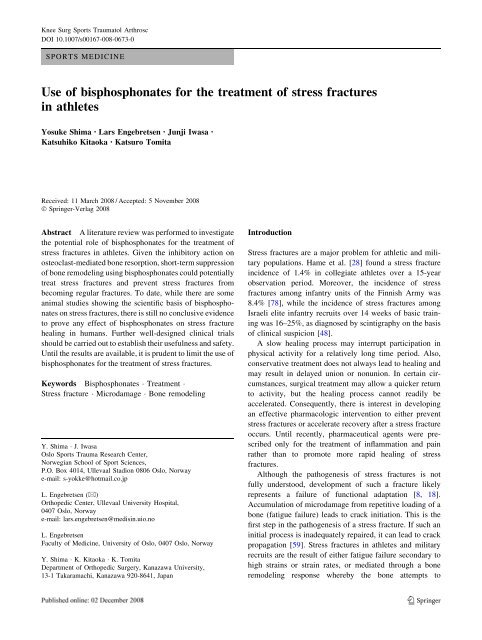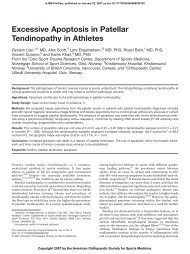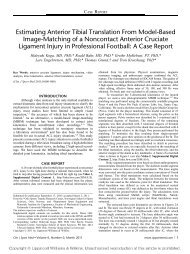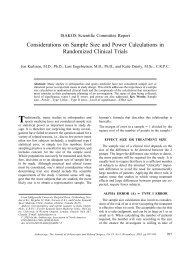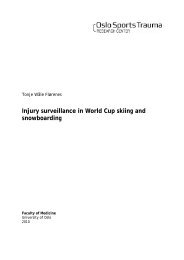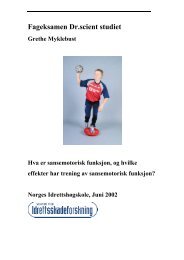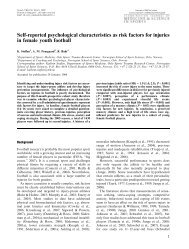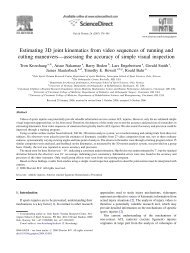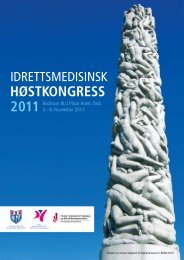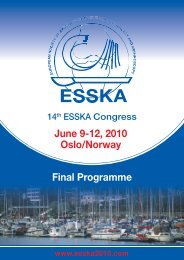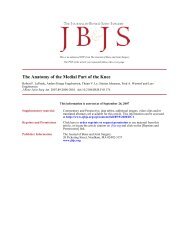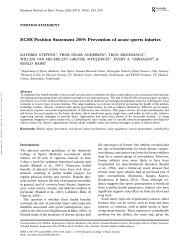Use of bisphosphonates for the treatment of stress fractures in athletes
Use of bisphosphonates for the treatment of stress fractures in athletes
Use of bisphosphonates for the treatment of stress fractures in athletes
Create successful ePaper yourself
Turn your PDF publications into a flip-book with our unique Google optimized e-Paper software.
Knee Surg Sports Traumatol ArthroscDOI 10.1007/s00167-008-0673-0SPORTS MEDICINE<strong>Use</strong> <strong>of</strong> <strong>bisphosphonates</strong> <strong>for</strong> <strong>the</strong> <strong>treatment</strong> <strong>of</strong> <strong>stress</strong> <strong>fractures</strong><strong>in</strong> <strong>athletes</strong>Yosuke Shima Æ Lars Engebretsen Æ Junji Iwasa ÆKatsuhiko Kitaoka Æ Katsuro TomitaReceived: 11 March 2008 / Accepted: 5 November 2008Ó Spr<strong>in</strong>ger-Verlag 2008Abstract A literature review was per<strong>for</strong>med to <strong>in</strong>vestigate<strong>the</strong> potential role <strong>of</strong> <strong>bisphosphonates</strong> <strong>for</strong> <strong>the</strong> <strong>treatment</strong> <strong>of</strong><strong>stress</strong> <strong>fractures</strong> <strong>in</strong> <strong>athletes</strong>. Given <strong>the</strong> <strong>in</strong>hibitory action onosteoclast-mediated bone resorption, short-term suppression<strong>of</strong> bone remodel<strong>in</strong>g us<strong>in</strong>g <strong>bisphosphonates</strong> could potentiallytreat <strong>stress</strong> <strong>fractures</strong> and prevent <strong>stress</strong> <strong>fractures</strong> frombecom<strong>in</strong>g regular <strong>fractures</strong>. To date, while <strong>the</strong>re are someanimal studies show<strong>in</strong>g <strong>the</strong> scientific basis <strong>of</strong> <strong>bisphosphonates</strong>on <strong>stress</strong> <strong>fractures</strong>, <strong>the</strong>re is still no conclusive evidenceto prove any effect <strong>of</strong> <strong>bisphosphonates</strong> on <strong>stress</strong> fractureheal<strong>in</strong>g <strong>in</strong> humans. Fur<strong>the</strong>r well-designed cl<strong>in</strong>ical trialsshould be carried out to establish <strong>the</strong>ir usefulness and safety.Until <strong>the</strong> results are available, it is prudent to limit <strong>the</strong> use <strong>of</strong><strong>bisphosphonates</strong> <strong>for</strong> <strong>the</strong> <strong>treatment</strong> <strong>of</strong> <strong>stress</strong> <strong>fractures</strong>.Keywords Bisphosphonates Treatment Stress fracture Microdamage Bone remodel<strong>in</strong>gY. Shima J. IwasaOslo Sports Trauma Research Center,Norwegian School <strong>of</strong> Sport Sciences,P.O. Box 4014, Ullevaal Stadion 0806 Oslo, Norwaye-mail: s-yokke@hotmail.co.jpL. Engebretsen (&)Orthopedic Center, Ullevaal University Hospital,0407 Oslo, Norwaye-mail: lars.engebretsen@medis<strong>in</strong>.uio.noL. EngebretsenFaculty <strong>of</strong> Medic<strong>in</strong>e, University <strong>of</strong> Oslo, 0407 Oslo, NorwayY. Shima K. Kitaoka K. TomitaDepartment <strong>of</strong> Orthopedic Surgery, Kanazawa University,13-1 Takaramachi, Kanazawa 920-8641, JapanIntroductionStress <strong>fractures</strong> are a major problem <strong>for</strong> athletic and militarypopulations. Hame et al. [28] found a <strong>stress</strong> fracture<strong>in</strong>cidence <strong>of</strong> 1.4% <strong>in</strong> collegiate <strong>athletes</strong> over a 15-yearobservation period. Moreover, <strong>the</strong> <strong>in</strong>cidence <strong>of</strong> <strong>stress</strong><strong>fractures</strong> among <strong>in</strong>fantry units <strong>of</strong> <strong>the</strong> F<strong>in</strong>nish Army was8.4% [78], while <strong>the</strong> <strong>in</strong>cidence <strong>of</strong> <strong>stress</strong> <strong>fractures</strong> amongIsraeli elite <strong>in</strong>fantry recruits over 14 weeks <strong>of</strong> basic tra<strong>in</strong><strong>in</strong>gwas 16–25%, as diagnosed by sc<strong>in</strong>tigraphy on <strong>the</strong> basis<strong>of</strong> cl<strong>in</strong>ical suspicion [48].A slow heal<strong>in</strong>g process may <strong>in</strong>terrupt participation <strong>in</strong>physical activity <strong>for</strong> a relatively long time period. Also,conservative <strong>treatment</strong> does not always lead to heal<strong>in</strong>g andmay result <strong>in</strong> delayed union or nonunion. In certa<strong>in</strong> circumstances,surgical <strong>treatment</strong> may allow a quicker returnto activity, but <strong>the</strong> heal<strong>in</strong>g process cannot readily beaccelerated. Consequently, <strong>the</strong>re is <strong>in</strong>terest <strong>in</strong> develop<strong>in</strong>gan effective pharmacologic <strong>in</strong>tervention to ei<strong>the</strong>r prevent<strong>stress</strong> <strong>fractures</strong> or accelerate recovery after a <strong>stress</strong> fractureoccurs. Until recently, pharmaceutical agents were prescribedonly <strong>for</strong> <strong>the</strong> <strong>treatment</strong> <strong>of</strong> <strong>in</strong>flammation and pa<strong>in</strong>ra<strong>the</strong>r than to promote more rapid heal<strong>in</strong>g <strong>of</strong> <strong>stress</strong><strong>fractures</strong>.Although <strong>the</strong> pathogenesis <strong>of</strong> <strong>stress</strong> <strong>fractures</strong> is notfully understood, development <strong>of</strong> such a fracture likelyrepresents a failure <strong>of</strong> functional adaptation [8, 18].Accumulation <strong>of</strong> microdamage from repetitive load<strong>in</strong>g <strong>of</strong> abone (fatigue failure) leads to crack <strong>in</strong>itiation. This is <strong>the</strong>first step <strong>in</strong> <strong>the</strong> pathogenesis <strong>of</strong> a <strong>stress</strong> fracture. If such an<strong>in</strong>itial process is <strong>in</strong>adequately repaired, it can lead to crackpropagation [59]. Stress <strong>fractures</strong> <strong>in</strong> <strong>athletes</strong> and militaryrecruits are <strong>the</strong> result <strong>of</strong> ei<strong>the</strong>r fatigue failure secondary tohigh stra<strong>in</strong>s or stra<strong>in</strong> rates, or mediated through a boneremodel<strong>in</strong>g response whereby <strong>the</strong> bone attempts to123
Knee Surg Sports Traumatol Arthroscstreng<strong>the</strong>n itself when subjected to high stra<strong>in</strong>s or stra<strong>in</strong>rates, or new stra<strong>in</strong> patterns. Milgrom et al. [49] haveshown <strong>in</strong> <strong>the</strong>ir <strong>in</strong> vivo human bone stra<strong>in</strong> gauge study thattibial <strong>stress</strong> <strong>fractures</strong> are likely due to bone remodel<strong>in</strong>g,while metatarsal <strong>stress</strong> <strong>fractures</strong> are caused by cyclicoverload<strong>in</strong>g alone.Over <strong>the</strong> past decade, <strong>bisphosphonates</strong> have been widelyused to treat a variety <strong>of</strong> bone diseases and have beenshown to <strong>in</strong>crease bone mass and decrease fracture risk <strong>in</strong>postmenopausal, osteoporotic women. The marked <strong>in</strong>hibitoryaction <strong>of</strong> <strong>bisphosphonates</strong> on osteoclast-mediated boneresorption has also led to successful <strong>treatment</strong> <strong>of</strong> pathologicprocesses associated with <strong>in</strong>creased bone remodel<strong>in</strong>gsuch as Paget’s disease, bone tumors, and metastases.Given <strong>the</strong>ir <strong>in</strong>hibitory action on osteoclast activity, shorttermsuppression <strong>of</strong> bone remodel<strong>in</strong>g us<strong>in</strong>g <strong>bisphosphonates</strong>could prevent <strong>the</strong> <strong>in</strong>itial bone loss observed dur<strong>in</strong>g<strong>the</strong> remodel<strong>in</strong>g response to high bone stra<strong>in</strong>s and potentiallyprevent <strong>stress</strong> <strong>fractures</strong> [19]. This concept is not new.Physicians have empirically treated <strong>athletes</strong> who sufferfrom <strong>stress</strong> <strong>fractures</strong> with <strong>bisphosphonates</strong>, but this iscontroversial and has not been well <strong>in</strong>vestigated [3, 24].The present review summarizes and discusses <strong>the</strong>current understand<strong>in</strong>g and <strong>the</strong> potential role <strong>of</strong> <strong>bisphosphonates</strong><strong>for</strong> <strong>the</strong> <strong>treatment</strong> and prevention <strong>of</strong> <strong>stress</strong><strong>fractures</strong> <strong>in</strong> <strong>athletes</strong>.remodel<strong>in</strong>g, which prevents <strong>the</strong> <strong>in</strong>creased porosity associatedwith remodel<strong>in</strong>g and ma<strong>in</strong>ta<strong>in</strong>s lower stra<strong>in</strong>s on <strong>the</strong>bone, can prevent <strong>stress</strong> <strong>fractures</strong>.One would expect that an <strong>in</strong>crease <strong>in</strong> bone remodel<strong>in</strong>gwould be accompanied by an elevation <strong>of</strong> serum or ur<strong>in</strong>ebiochemical markers that reflect <strong>the</strong> remodel<strong>in</strong>g process. In<strong>the</strong>ir prospective study, Murguia et al. [53] detected asignificant <strong>in</strong>crease <strong>in</strong> plasma hydroxyprol<strong>in</strong>e dur<strong>in</strong>g <strong>the</strong>first week <strong>of</strong> military tra<strong>in</strong><strong>in</strong>g <strong>in</strong> a group <strong>of</strong> recruits whosubsequently presented with <strong>stress</strong> <strong>fractures</strong>, compared tothose who did not. This showed that an <strong>in</strong>itially higherbone remodel<strong>in</strong>g rate is a risk factor <strong>for</strong> subsequent <strong>stress</strong><strong>fractures</strong>. Accord<strong>in</strong>g to this result, preventive bisphosphonate<strong>treatment</strong> may be feasible <strong>for</strong> those who have<strong>in</strong>creased bone remodel<strong>in</strong>g at basel<strong>in</strong>e. However, Bennellet al. [8] reported that bone remodel<strong>in</strong>g <strong>in</strong> <strong>athletes</strong> whodeveloped <strong>stress</strong> <strong>fractures</strong> was not different from those whodid not develop <strong>stress</strong> <strong>fractures</strong> at basel<strong>in</strong>e, or immediatelyprior or subsequent to <strong>the</strong> start <strong>of</strong> bone pa<strong>in</strong>. The resultsfrom military recruits may not generalize to <strong>athletes</strong> as <strong>the</strong>yrepresent a different population. Failure to detect <strong>in</strong>creasedbone remodel<strong>in</strong>g, ei<strong>the</strong>r prior to or follow<strong>in</strong>g <strong>the</strong> onset <strong>of</strong><strong>stress</strong> <strong>fractures</strong> <strong>in</strong> <strong>athletes</strong>, may reflect overall total bodybone remodel<strong>in</strong>g and <strong>the</strong> tests may not be sufficientlysensitive enough to detect locally accelerated boneremodel<strong>in</strong>g.Pathogenesis <strong>of</strong> <strong>stress</strong> <strong>fractures</strong> and <strong>the</strong> relationshipto <strong>bisphosphonates</strong>As stated above, <strong>stress</strong> <strong>fractures</strong> occur when a bone fails toremodel adequately follow<strong>in</strong>g <strong>the</strong> application <strong>of</strong> repetitivesub-threshold <strong>stress</strong>. The first stage <strong>of</strong> bone remodel<strong>in</strong>g<strong>in</strong>volves bone resorption, which fur<strong>the</strong>r weakens <strong>the</strong>already compromised bone [19]. A ma<strong>the</strong>matical modelproposes that <strong>the</strong> porosity <strong>in</strong>troduced by remodel<strong>in</strong>g contributesto an unstable situation <strong>in</strong> which a <strong>stress</strong> fracturewill occur [44]. Experimental studies with a rabbit impulsiveload<strong>in</strong>g model [17] also suggested that a positivefeedback between load<strong>in</strong>g and remodel<strong>in</strong>g might be afeature <strong>of</strong> <strong>stress</strong> fracture pathogenesis. By 6 weeks <strong>of</strong>load<strong>in</strong>g, activation <strong>of</strong> new bone remodel<strong>in</strong>g had <strong>in</strong>creasedfur<strong>the</strong>r still and <strong>the</strong>re was a tenfold <strong>in</strong>crease <strong>in</strong> bone microdamage.The <strong>in</strong>cidence <strong>of</strong> overt <strong>stress</strong> <strong>fractures</strong> <strong>in</strong> <strong>the</strong>seanimals had <strong>in</strong>creased to 68% after 6 weeks. These datasuggest that overload<strong>in</strong>g first creates a biological remodel<strong>in</strong>gresponse, which is associated with <strong>the</strong> early signs <strong>of</strong> a<strong>stress</strong> fracture. Cont<strong>in</strong>ued load<strong>in</strong>g causes acceleration <strong>of</strong>bone microdamage accumulation, which fur<strong>the</strong>r <strong>in</strong>creases<strong>the</strong> <strong>in</strong>cidence <strong>of</strong> <strong>stress</strong> <strong>fractures</strong>, perhaps through a positivefeedback mechanism [19]. Taken toge<strong>the</strong>r, <strong>the</strong>se experimentshave suggested that <strong>the</strong> suppression <strong>of</strong> boneEffect <strong>of</strong> <strong>bisphosphonates</strong> on fracture heal<strong>in</strong>gOver <strong>the</strong> years, <strong>the</strong>re have been concerns about whe<strong>the</strong>r ornot <strong>bisphosphonates</strong> <strong>in</strong>terfere with <strong>the</strong> fracture heal<strong>in</strong>g.Because <strong>the</strong>y suppress bone remodel<strong>in</strong>g, one might expectthat <strong>bisphosphonates</strong> <strong>in</strong>terfere with fracture repair. Li et al.[37] have reported <strong>in</strong> a grow<strong>in</strong>g rat model us<strong>in</strong>g <strong>in</strong>cadronatethat bisphosphonate <strong>treatment</strong> resulted <strong>in</strong> a largerfracture callus and delayed maturation <strong>of</strong> <strong>the</strong> fracture.Alendronate <strong>treatment</strong> also suppressed remodel<strong>in</strong>g <strong>of</strong> <strong>the</strong>fracture callus <strong>in</strong> ovariectomized rats [20]. These changesmay be secondary to <strong>in</strong>hibition <strong>of</strong> bone resorption becausebone <strong>for</strong>mation and resorption are <strong>in</strong>timately l<strong>in</strong>ked. Conversely,<strong>the</strong>re are reassur<strong>in</strong>g reports on this topic that showfracture callus remodel<strong>in</strong>g is not a problem <strong>in</strong> severalanimal models unless very high doses <strong>of</strong> <strong>bisphosphonates</strong>are used [7, 25].In contrast to <strong>the</strong>se concerns, <strong>the</strong>re are now severalreports suggest<strong>in</strong>g that <strong>bisphosphonates</strong> may actuallyenhance fracture repair, probably by stabiliz<strong>in</strong>g <strong>the</strong> fracturecallus [42]. O<strong>the</strong>r studies relevant to this problem <strong>in</strong>clude<strong>the</strong> improved osseo<strong>in</strong>tegration <strong>of</strong> metal implants <strong>in</strong> ovariectomizedrats treated with ibandronate [34]. There are alsopotential applications <strong>of</strong> <strong>bisphosphonates</strong> <strong>in</strong> orthopedics,<strong>in</strong>clud<strong>in</strong>g improved heal<strong>in</strong>g <strong>in</strong> distraction osteogenesis [39,123
Knee Surg Sports Traumatol Arthrosc40], which conserves bone architecture after osteonecrosis[35, 41, 60].The process <strong>of</strong> bone and fracture repair consists <strong>of</strong> ananabolic (bone <strong>for</strong>m<strong>in</strong>g) response and a catabolic (boneresorb<strong>in</strong>g) response. In <strong>the</strong> absence <strong>of</strong> an anabolicresponse, anti-catabolic <strong>treatment</strong> alone does not lead tounion <strong>in</strong> a rat femoral critical defect model [42]. Bisphosphonate<strong>treatment</strong> may require anabolic conjunctive<strong>the</strong>rapy to ensure enhanced successful repair [16, 42], butthis cannot be directly applied to <strong>the</strong> <strong>treatment</strong> <strong>of</strong> <strong>stress</strong><strong>fractures</strong> as <strong>the</strong>y represent different features. Bisphosphonatesas anti-catabolic agents would be consideredsatisfactory <strong>for</strong> <strong>the</strong> <strong>treatment</strong> <strong>of</strong> <strong>stress</strong> <strong>fractures</strong>, assum<strong>in</strong>gthat most <strong>athletes</strong> with <strong>stress</strong> <strong>fractures</strong>, except <strong>in</strong> somespecial situations, e.g., female athlete triad have a normalanabolic bone homeostatic response. However, if systemicbone morphogenetic prote<strong>in</strong>s are available as anabolicagents, us<strong>in</strong>g <strong>the</strong>m <strong>in</strong> comb<strong>in</strong>ation with <strong>bisphosphonates</strong>[42] may be more efficacious <strong>for</strong> <strong>the</strong> <strong>treatment</strong> <strong>of</strong> <strong>stress</strong><strong>fractures</strong>.In recent years, dos<strong>in</strong>g regimens used <strong>for</strong> treat<strong>in</strong>g osteoporosishave evolved such that <strong>the</strong> time between doses has<strong>in</strong>creased. From rout<strong>in</strong>e daily <strong>the</strong>rapy, oral <strong>the</strong>rapy is nowstandardized to weekly dos<strong>in</strong>g <strong>for</strong> alendronate and risedronateand monthly dos<strong>in</strong>g <strong>for</strong> ibandronate. Recentosteoporosis trials support <strong>the</strong> use <strong>of</strong> <strong>in</strong>travenous ibandronateat 3 month <strong>in</strong>tervals, and zoledronic acid (ZA) as aonce-yearly <strong>in</strong>fusion [12, 21]. Previous precl<strong>in</strong>ical studiesus<strong>in</strong>g cont<strong>in</strong>uous bisphosphonate <strong>the</strong>rapy may not be,<strong>the</strong>re<strong>for</strong>e, relevant to such <strong>in</strong>termittent dos<strong>in</strong>g regimens [5].A s<strong>in</strong>gle systemic dose <strong>of</strong> pamidronate adm<strong>in</strong>istered at <strong>the</strong>time <strong>of</strong> fracture <strong>in</strong>creased bone m<strong>in</strong>eral content (BMC),volume, and strength <strong>of</strong> united <strong>fractures</strong> [4]. There werefur<strong>the</strong>r <strong>in</strong>creases <strong>in</strong> bone volume and strength when <strong>the</strong>dose <strong>of</strong> zoledronic acid was delayed by 2 weeks <strong>in</strong> a ratfemoral critical defect model [42]. Amanat et al. [5]recently reported that delay<strong>in</strong>g <strong>the</strong> s<strong>in</strong>gle dose systemiczoledronic acid adm<strong>in</strong>istration to 1 or 2 weeks after <strong>the</strong>occurrence <strong>of</strong> <strong>the</strong> fracture <strong>in</strong>creased callus volume, callusBMC, and mechanical strength <strong>in</strong> a rat fracture model.Bisphosphonates are well known to reduce pa<strong>in</strong> <strong>in</strong> awide variety <strong>of</strong> underly<strong>in</strong>g bone conditions, such as osteolyticmetastasis, multiple myeloma, and localizedtransient osteoporosis (LTO; bone marrow edema syndrome)[61, 62]. Increased bone remodel<strong>in</strong>g and low bonem<strong>in</strong>eral density (BMD) <strong>in</strong>dicate a potential role <strong>for</strong> bisphosphonate<strong>the</strong>rapy <strong>in</strong> LTO. Miltner et al. [51] reported acase <strong>of</strong> transient osteoporosis <strong>of</strong> <strong>the</strong> navicular bone <strong>in</strong> a400 m spr<strong>in</strong>ter and <strong>the</strong> successful <strong>treatment</strong> with alendronate.This relief <strong>of</strong> bone pa<strong>in</strong> is mediated not only through<strong>the</strong> <strong>in</strong>hibition <strong>of</strong> osteoclast function, but also through an<strong>in</strong>hibition <strong>of</strong> cytok<strong>in</strong>e production by macrophages andprostagland<strong>in</strong> syn<strong>the</strong>sis by a variety <strong>of</strong> cells [23].Recently, extracorporeal shock wave <strong>the</strong>rapy was shownto be an effective method to treat <strong>in</strong>tractable <strong>stress</strong> <strong>fractures</strong><strong>in</strong> <strong>athletes</strong> [72]. Shock wave <strong>the</strong>rapy <strong>in</strong>ducesangiogenesis-related growth factors and stimulates neovascularization,which improves blood supply and<strong>in</strong>creases cell proliferation at <strong>the</strong> fracture site. Hausmanet al. [29] showed that angiogenesis is essential to <strong>the</strong> veryearly stages <strong>of</strong> fracture heal<strong>in</strong>g, and suggested thatimpairment <strong>of</strong> fracture heal<strong>in</strong>g may be an adverse effect <strong>of</strong>cl<strong>in</strong>ical <strong>treatment</strong>s with anti-angiogenic drugs. Consider<strong>in</strong>g<strong>the</strong> anti-angiogenic properties [26, 65, 83], adm<strong>in</strong>istration<strong>of</strong> nitrogen-conta<strong>in</strong><strong>in</strong>g <strong>bisphosphonates</strong> at <strong>the</strong> <strong>in</strong>itial stage<strong>of</strong> fracture heal<strong>in</strong>g may have an adverse effect on <strong>stress</strong>fracture <strong>treatment</strong>.Bisphosphonates and fatigue load<strong>in</strong>gIn a short-term alendronate <strong>treatment</strong> study <strong>in</strong> rats [6],resorption space density was suppressed <strong>in</strong> <strong>the</strong> adaptedgroups receiv<strong>in</strong>g alendronate <strong>treatment</strong>. The lowestresorption space density values were found <strong>in</strong> <strong>the</strong> adaptedgroups that were pretreated with alendronate. However,work-to-failure was significantly improved <strong>in</strong> <strong>the</strong> adaptedgroups with post-<strong>treatment</strong> but not <strong>in</strong> <strong>the</strong> pre-<strong>treatment</strong>group. There<strong>for</strong>e, pre-<strong>treatment</strong> with alendronate had a lessadvantageous effect on adaptation to fatigue when comparedwith post-<strong>treatment</strong>. In addition, <strong>the</strong> authorssuggested that a <strong>treatment</strong> period <strong>of</strong> 14 days was too shortto have any significant effect <strong>of</strong> alendronate on skeletalremodel<strong>in</strong>g dur<strong>in</strong>g functional adaptation. Dur<strong>in</strong>g postfatigue<strong>treatment</strong>, <strong>in</strong>hibition <strong>of</strong> osteoclastic remodel<strong>in</strong>g byalendronate may have been reduced by physiological <strong>stress</strong>[6]. In mice receiv<strong>in</strong>g both glucocorticoid and alendronateconcomitantly, <strong>the</strong> expected apoptotic effect <strong>of</strong> <strong>bisphosphonates</strong>on osteoclasts was reduced [80].Over-suppression and microdamage accumulationConcerns have been raised about potential over-suppression<strong>of</strong> bone remodel<strong>in</strong>g dur<strong>in</strong>g long-term use <strong>of</strong> <strong>bisphosphonates</strong>.Although <strong>the</strong> adm<strong>in</strong>istration <strong>of</strong> <strong>bisphosphonates</strong> <strong>for</strong><strong>athletes</strong> would be a relatively short-term <strong>treatment</strong>, physiciansshould at least know about <strong>the</strong> long-term risks. Afterbone uptake, <strong>bisphosphonates</strong> are liberated aga<strong>in</strong> only when<strong>the</strong> bone <strong>in</strong> which <strong>the</strong>y are deposited is resorbed. Thus, <strong>the</strong>half-life <strong>of</strong> <strong>bisphosphonates</strong> <strong>in</strong> bone is very long, rang<strong>in</strong>gfrom 1 to 10 years among different species, and is dependentlargely on <strong>the</strong> rate <strong>of</strong> bone remodel<strong>in</strong>g [38]. Thereappears to be no progression <strong>of</strong> <strong>the</strong> anti-resorptive effectwith time even when <strong>the</strong> compounds are given cont<strong>in</strong>uously,which suggests that bisphosphonate buried <strong>in</strong> <strong>the</strong>123
Knee Surg Sports Traumatol Arthroscbone is <strong>in</strong>active, at least as long as it rema<strong>in</strong>s sequestered<strong>the</strong>re [63]. In dog ribs treated with risedronate or alendronate<strong>for</strong> 1 year, alendronate has been shown to <strong>in</strong>hibitnormal microdamage repair that arises from a markedsuppression <strong>of</strong> bone remodel<strong>in</strong>g, which <strong>in</strong> turn results <strong>in</strong>accumulation <strong>of</strong> microdamage [2, 37, 46, 47]. Boneremodel<strong>in</strong>g decreased 53 and 68% as a result <strong>of</strong> risedronateor alendronate <strong>treatment</strong>s, while <strong>the</strong> correspond<strong>in</strong>g <strong>in</strong>crease<strong>in</strong> microcrack damage was 490 and 630%, respectively. Inaddition, <strong>the</strong> energy required to fracture <strong>the</strong> rib was significantlydecreased by 19% <strong>in</strong> <strong>the</strong> alendronate <strong>treatment</strong>group. While <strong>the</strong>se experiments used bisphophonate dosesseveral times higher than <strong>the</strong> equivalent doses <strong>for</strong> humanosteoporosis patients, it strongly suggests that boneremodel<strong>in</strong>g is necessary to prevent fatigue microdamagefrom accumulat<strong>in</strong>g and weaken<strong>in</strong>g <strong>the</strong> bone.Long-term use (5–10 years) <strong>of</strong> <strong>bisphosphonates</strong> <strong>for</strong>osteoporosis <strong>the</strong>rapy appears to be safe [11, 15]. However,<strong>the</strong>re is a case series [55] that revealed severe deficiencies<strong>in</strong> bone <strong>for</strong>mation <strong>in</strong> n<strong>in</strong>e patients on long-term alendronate<strong>the</strong>rapy (3–8 years). This resulted <strong>in</strong> an <strong>in</strong>creased susceptibilityto non-sp<strong>in</strong>al <strong>fractures</strong> that healed poorly. Inaddition, Ott [55] speculated that long-term alendronate<strong>treatment</strong> <strong>in</strong> humans might impair mechanical bonestrength. This suggestion was based on <strong>the</strong> apparent<strong>in</strong>crease <strong>in</strong> <strong>the</strong> rate <strong>of</strong> vertebral <strong>fractures</strong> with prolonged<strong>treatment</strong> [75], though refuted by <strong>the</strong> authors <strong>of</strong> that report[76]. The <strong>in</strong>duction <strong>of</strong> osteopetrotic-like lesions <strong>in</strong> a childtreated with extremely high doses <strong>of</strong> pamidronate has alsobeen reported [81]. Lenart et al. [36] recently showed thatlow-energy <strong>fractures</strong> <strong>of</strong> <strong>the</strong> femoral shaft with a simple,transverse pattern and hypertrophy <strong>of</strong> <strong>the</strong> diaphyseal cortexwere associated with alendronate use. They suggested thatthis may result from propagation <strong>of</strong> <strong>stress</strong> <strong>fractures</strong> whoserepair was retarded by dim<strong>in</strong>ished osteoclast activity andimpaired microdamage repair result<strong>in</strong>g from prolongeduse. Long-term suppression <strong>of</strong> bone remodel<strong>in</strong>g by bisphosphonatealso <strong>in</strong>creased non-enzymatic cross-l<strong>in</strong>k<strong>in</strong>gand could result <strong>in</strong> brittle bones [64, 68].Potential adverse effectsIt is always necessary to consider <strong>the</strong> risks and benefits<strong>of</strong> any prescribed medication. When treat<strong>in</strong>g a non-lifethreaten<strong>in</strong>g disease such as <strong>stress</strong> <strong>fractures</strong>, <strong>of</strong>f-label use <strong>of</strong>a drug demands special caution. In a case series us<strong>in</strong>g<strong>in</strong>travenous pamidronate <strong>for</strong> <strong>the</strong> <strong>treatment</strong> <strong>of</strong> <strong>stress</strong> <strong>fractures</strong>,<strong>the</strong> most common short-term side effects werenausea, fatigue, arthralgias, and myalgias [71]. All <strong>of</strong> <strong>the</strong>side effects resolved with<strong>in</strong> 24–48 h. S<strong>in</strong>ce nausea was <strong>the</strong>ma<strong>in</strong> problem with <strong>the</strong> 90 mg dose when compared with<strong>the</strong> 60 mg dose, <strong>the</strong> authors recommended us<strong>in</strong>g a 60 mg<strong>treatment</strong> dose. On <strong>the</strong> o<strong>the</strong>r hand, <strong>in</strong> a randomized controlledstudy <strong>of</strong> military recruits, risedronate use <strong>for</strong> <strong>the</strong>prevention <strong>of</strong> <strong>stress</strong> <strong>fractures</strong> had no more side effects thana placebo <strong>treatment</strong> [50].Oral <strong>bisphosphonates</strong> can result <strong>in</strong> stomach upset,<strong>in</strong>flammation, and erosions <strong>of</strong> <strong>the</strong> esophagus, which is <strong>the</strong>ma<strong>in</strong> problem <strong>of</strong> all oral nitrogen-conta<strong>in</strong><strong>in</strong>g preparations.This can be prevented by rema<strong>in</strong><strong>in</strong>g seated upright <strong>for</strong> 30–60 m<strong>in</strong> after tak<strong>in</strong>g <strong>the</strong> medication. A number <strong>of</strong> cases <strong>of</strong>severe bone, jo<strong>in</strong>t, or musculoskeletal pa<strong>in</strong> associated withoral <strong>bisphosphonates</strong>, alendronate and risedronate, havebeen reported [84]. These symptoms improved afterdiscont<strong>in</strong>uation <strong>of</strong> <strong>the</strong> drug <strong>treatment</strong>. Intravenousnitrogen-conta<strong>in</strong><strong>in</strong>g <strong>bisphosphonates</strong> can give undesirable<strong>in</strong>flammatory reactions, <strong>in</strong>clud<strong>in</strong>g an <strong>in</strong>crease <strong>in</strong> acutephaseprote<strong>in</strong>s, fever, flu-like symptoms, and ophthalmic<strong>in</strong>flammation, after <strong>the</strong> first <strong>in</strong>fusion [1, 43, 69, 73]. Theseare thought to occur because <strong>of</strong> <strong>the</strong>ir potential to activatehuman c,d-T cells [74]. Notably, <strong>the</strong>se symptoms do notrecur with subsequent <strong>in</strong>fusions. Some <strong>of</strong> <strong>the</strong> <strong>in</strong>travenous<strong>bisphosphonates</strong>, <strong>in</strong> particular zoledronic acid, have nephrotoxicpotential [14, 30].Recently, ano<strong>the</strong>r potential complication <strong>of</strong> <strong>the</strong>seagents has surfaced. Osteonecrosis <strong>of</strong> <strong>the</strong> jaw (ONJ)occurred <strong>in</strong> multiple myeloma or metastatic cancerpatients treated with <strong>in</strong>travenous <strong>bisphosphonates</strong> [10, 45,67]. These reports have led to a grow<strong>in</strong>g concern about<strong>the</strong> safety <strong>of</strong> oral <strong>bisphosphonates</strong> <strong>in</strong> patients with osteoporosis.In a literature review, Pazianas et al. [58]identified 26 cases <strong>of</strong> ONJ <strong>in</strong> patients receiv<strong>in</strong>g oral <strong>bisphosphonates</strong>.Consider<strong>in</strong>g that millions <strong>of</strong> patients havebeen prescribed <strong>bisphosphonates</strong> <strong>for</strong> <strong>the</strong> <strong>treatment</strong> <strong>of</strong>osteoporosis, this prevalence <strong>of</strong> ONJ was relatively low.The mandible was more commonly affected than <strong>the</strong>maxilla (2:1 ratio), and 60% <strong>of</strong> cases were preceded by adental surgical procedure [82]. The most common characteristics<strong>of</strong> those who developed ONJ were an ageC60 years (only one patient was aged \40 years), femalesex, and patients that had received previous <strong>in</strong>vasivedental <strong>treatment</strong> [58]. At present, <strong>the</strong>re is <strong>in</strong>sufficient dataavailable to construct evidence-based guidel<strong>in</strong>es <strong>for</strong> <strong>the</strong>prevention and <strong>the</strong>rapy <strong>of</strong> ONJ. In <strong>the</strong> case <strong>of</strong> adm<strong>in</strong>istration<strong>of</strong> <strong>bisphosphonates</strong> to <strong>athletes</strong>, a physician shouldcheck <strong>the</strong>ir previous dental history and current dentalcondition, and <strong>in</strong><strong>for</strong>m <strong>the</strong> patients about <strong>the</strong> low risk <strong>of</strong>develop<strong>in</strong>g ONJ, irrespective <strong>of</strong> <strong>the</strong> route and frequency<strong>of</strong> bisphosphonate adm<strong>in</strong>istration.Because <strong>of</strong> <strong>in</strong>creased sports participation <strong>in</strong> children andadolescents, <strong>athletes</strong> with open physis are predisposed to<strong>stress</strong> <strong>fractures</strong>. There are some concerns about <strong>the</strong> impact<strong>of</strong> <strong>bisphosphonates</strong> on open physis, chondro-osseousmodel<strong>in</strong>g, and consequent growth <strong>in</strong> o<strong>the</strong>rwise normal longbones. Smith et al. [70] showed that nitrogen-conta<strong>in</strong><strong>in</strong>g123
Knee Surg Sports Traumatol Arthrosc<strong>bisphosphonates</strong> can cause transient effects on physeal cellmorphology and retention <strong>of</strong> cartilag<strong>in</strong>ous matrix, whichco<strong>in</strong>cides with a growth disturbance (3% decrease <strong>in</strong> f<strong>in</strong>allong bone length), even <strong>in</strong> a short-term 6-week grow<strong>in</strong>ganimal model. On <strong>the</strong> o<strong>the</strong>r hand, <strong>in</strong> a radiographic quantificationstudy, Ward et al. [79] showed that cl<strong>in</strong>icallyrelevant doses <strong>of</strong> <strong>bisphosphonates</strong> did not necessarily disturbphyseal model<strong>in</strong>g <strong>in</strong> <strong>the</strong> distal femur throughoutchildhood. In a case series by van Persijn van Meerten [77],bisphosphonate <strong>treatment</strong> <strong>in</strong> children with open physischaracteristically resulted <strong>in</strong> epi- and metaphyseal sclerosis,but this was a reversible phenomenon. However, so far<strong>the</strong>re is a lack <strong>of</strong> evidence about <strong>the</strong> safe use <strong>of</strong> <strong>bisphosphonates</strong><strong>for</strong> adolescent <strong>athletes</strong> with open physis.Although <strong>the</strong> pharmacologic activities <strong>of</strong> <strong>bisphosphonates</strong>are reta<strong>in</strong>ed <strong>for</strong> a period <strong>of</strong> time after cessation <strong>of</strong><strong>treatment</strong>, <strong>the</strong> effects <strong>of</strong> <strong>bisphosphonates</strong> are likely transientand may disappear once <strong>the</strong> drug is withdrawn.There<strong>for</strong>e, short-term exposure to <strong>bisphosphonates</strong> <strong>for</strong> <strong>the</strong><strong>treatment</strong> <strong>of</strong> <strong>stress</strong> <strong>fractures</strong> would not be expected to causelong-term deleterious effects on <strong>the</strong> skeleton [19].The safety <strong>of</strong> <strong>bisphosphonates</strong> <strong>in</strong> women who arepregnant, or are <strong>of</strong> childbear<strong>in</strong>g age, also has not beenclearly established. In rat studies, alendronate was found tocross <strong>the</strong> placenta and accumulate <strong>in</strong> fetal bone [57], where<strong>the</strong> presence <strong>of</strong> alendronate may <strong>in</strong>terfere with fetal bonem<strong>in</strong>eralization and development. The half-life <strong>of</strong> <strong>bisphosphonates</strong>is proportional to bone remodel<strong>in</strong>g time, whichmay be over 1 year <strong>in</strong> rats [52]. There<strong>for</strong>e, it may takeseveral years <strong>for</strong> a young woman to completely clear <strong>the</strong>drug from her body. Any harmful effects on <strong>the</strong> fetus couldpotentially persist <strong>for</strong> years after <strong>the</strong> <strong>in</strong>itial <strong>treatment</strong>.However, <strong>the</strong>re have been no case reports to date <strong>of</strong> teratogeniceffects <strong>in</strong> humans.Cl<strong>in</strong>ical <strong>in</strong>tervention us<strong>in</strong>g <strong>bisphosphonates</strong><strong>for</strong> <strong>stress</strong> <strong>fractures</strong>To date, <strong>the</strong>re have been no randomized controlled studiesabout bisphosphonate <strong>treatment</strong> after <strong>stress</strong> <strong>fractures</strong>.However, a case series [71] recently reported <strong>the</strong> successfuluse <strong>of</strong> <strong>in</strong>travenous pamidronate <strong>in</strong> five <strong>in</strong>tercollegiatefemale <strong>athletes</strong> with tibial <strong>stress</strong> <strong>fractures</strong>. The five subjectsshowed bone scan results consistent with <strong>stress</strong> <strong>fractures</strong>,with four <strong>of</strong> five <strong>athletes</strong> acquir<strong>in</strong>g symptoms more than5 months be<strong>for</strong>e <strong>treatment</strong>. A 30 mg test dose <strong>of</strong> pamidronatewas given <strong>in</strong>travenously over 2 h, followed by fouradditional <strong>treatment</strong>s at weekly <strong>in</strong>tervals <strong>in</strong> 60 or 90 mgamounts. With <strong>the</strong> <strong>in</strong>itial <strong>treatment</strong>, four <strong>of</strong> five subjectswere able to cont<strong>in</strong>ue tra<strong>in</strong><strong>in</strong>g without symptoms with<strong>in</strong>72 h. Only one patient missed 3 weeks <strong>of</strong> tra<strong>in</strong><strong>in</strong>g. Thesymptoms resolved <strong>in</strong> all five <strong>athletes</strong> with<strong>in</strong> a few weeks<strong>of</strong> <strong>treatment</strong> and all rema<strong>in</strong>ed asymptomatic at a m<strong>in</strong>imum<strong>of</strong> 49 months <strong>of</strong> follow-up. Although no decision regard<strong>in</strong>g<strong>the</strong> efficacy <strong>of</strong> <strong>bisphosphonates</strong> <strong>in</strong> <strong>stress</strong> fracture <strong>treatment</strong>can be made from this uncontrolled study with a smallpopulation, <strong>the</strong>se <strong>in</strong>vestigators believe that <strong>the</strong> <strong>treatment</strong> ispromis<strong>in</strong>g and plan to do a prospective study.There has been only one randomized controlled studyconcern<strong>in</strong>g <strong>the</strong> prevention <strong>of</strong> <strong>stress</strong> <strong>fractures</strong> us<strong>in</strong>g oralbisphosphonate. Milgrom et al. [50] conducted a study <strong>of</strong>324 male Israeli military recruits us<strong>in</strong>g 30 mg risedronate,or a placebo, daily <strong>for</strong> 10 days dur<strong>in</strong>g <strong>the</strong> first 2 weeks <strong>of</strong>basic tra<strong>in</strong><strong>in</strong>g, be<strong>for</strong>e <strong>the</strong>y started any physically demand<strong>in</strong>gtra<strong>in</strong><strong>in</strong>g. After <strong>the</strong> <strong>in</strong>itial 10-day load<strong>in</strong>g dose, subjectsreceived a 30 mg ma<strong>in</strong>tenance dose <strong>of</strong> risedronate, once aweek <strong>for</strong> <strong>the</strong> next 12 weeks <strong>of</strong> <strong>the</strong> rema<strong>in</strong><strong>in</strong>g 13-weektra<strong>in</strong><strong>in</strong>g period. The primary outcome measure was <strong>the</strong>occurrence <strong>of</strong> a <strong>stress</strong> fracture dur<strong>in</strong>g <strong>the</strong> study period.Over one-third <strong>of</strong> <strong>the</strong> entire study group discont<strong>in</strong>ued<strong>treatment</strong> because <strong>of</strong> concerns regard<strong>in</strong>g potential adverseside effects, although only two soldiers actually reportedsymptoms. Despite <strong>the</strong> early dropout rate, <strong>in</strong>tention-to-treatanalysis and per-protocol analysis showed risedronate didnot lower <strong>the</strong> <strong>in</strong>cidence <strong>of</strong> <strong>stress</strong> <strong>fractures</strong>. Instead, <strong>the</strong><strong>in</strong>cidence <strong>of</strong> fatigue or <strong>stress</strong> <strong>fractures</strong> <strong>in</strong> <strong>the</strong> distal limb(tibia and metatarsus) was higher <strong>in</strong> subjects that receivedrisedronate <strong>the</strong>rapy be<strong>for</strong>e <strong>the</strong> period <strong>of</strong> strenuous activity,although this f<strong>in</strong>d<strong>in</strong>g was not statistically significant. Thisobservation fits with <strong>the</strong> rat model data from Barrett et al.[6]. They suggested that short-term pre-emptive <strong>treatment</strong>with alendronate did not protect bone from fatigue <strong>in</strong>jury <strong>in</strong>a rat ulna cyclic fatigue load<strong>in</strong>g model. Fur<strong>the</strong>r research iswarranted regard<strong>in</strong>g <strong>stress</strong> fracture prevention <strong>in</strong> bothmilitary and athletic populations.DiscussionGiven <strong>the</strong> pathogenesis <strong>of</strong> <strong>stress</strong> <strong>fractures</strong>, <strong>the</strong>re is reasonto consider <strong>the</strong> potential role <strong>of</strong> <strong>bisphosphonates</strong> <strong>for</strong> <strong>the</strong><strong>treatment</strong> <strong>of</strong> <strong>stress</strong> <strong>fractures</strong> based on limited <strong>in</strong><strong>for</strong>mation.However, no solid evidence-based <strong>in</strong>terventions to preventlower extremity <strong>stress</strong> reactions or <strong>fractures</strong> has existed s<strong>of</strong>ar [66]. Moreover, <strong>the</strong> present review confirmed that <strong>the</strong>reis no conclusive evidence to prove any effect <strong>of</strong> <strong>bisphosphonates</strong>on <strong>stress</strong> fracture heal<strong>in</strong>g <strong>in</strong> humans.Whenever we consider a <strong>treatment</strong> plan <strong>for</strong> <strong>stress</strong> <strong>fractures</strong>,we must understand why <strong>the</strong> <strong>in</strong>jury has occurred <strong>in</strong> <strong>the</strong>first place. A dynamic balance exists between <strong>the</strong> accumulation<strong>of</strong> microdamage and <strong>the</strong> host repair processes. Any<strong>in</strong>tr<strong>in</strong>sic and extr<strong>in</strong>sic factors that disrupt this dynamicbalance can <strong>in</strong>crease <strong>the</strong> risk <strong>of</strong> <strong>stress</strong> fracture. Intr<strong>in</strong>sicfactors <strong>in</strong>clude metabolic state, menstrual patterns, level <strong>of</strong>fitness, muscle endurance, anatomic alignment, and bone123
Knee Surg Sports Traumatol Arthroscvascularity [27, 33]. Extr<strong>in</strong>sic factors <strong>in</strong>clude tra<strong>in</strong><strong>in</strong>g regimens,nutritional or dietary habits, and play<strong>in</strong>g equipment(footwear, play<strong>in</strong>g surface, etc.). Understand<strong>in</strong>g <strong>the</strong>seunderly<strong>in</strong>g causes are essential be<strong>for</strong>e any <strong>treatment</strong> <strong>of</strong><strong>stress</strong> <strong>fractures</strong> is started.It is estimated that [50% <strong>of</strong> a dose <strong>of</strong> <strong>in</strong>travenousbisphosphonate is bioavailable <strong>for</strong> <strong>in</strong>corporation <strong>in</strong>to <strong>the</strong>bone matrix, compared with \1% <strong>of</strong> oral bisphosphonate[9, 22]. Intravenous <strong>bisphosphonates</strong> have improved bioavailabilityand do not produce <strong>the</strong> gastro<strong>in</strong>test<strong>in</strong>al sideeffects that oral <strong>bisphosphonates</strong> do; however, <strong>the</strong>re aresome possibilities <strong>of</strong> non-trivial side effects. Intravenousadm<strong>in</strong>istration <strong>of</strong> clodronate and pamidronate requireslow, prolonged <strong>in</strong>fusion to avoid renal toxicity [13] and<strong>the</strong>re<strong>for</strong>e must be undertaken <strong>in</strong> a hospital sett<strong>in</strong>g. This is<strong>in</strong>convenient, labor-<strong>in</strong>tensive, and costly and can beassociated with complications [56]. Because <strong>the</strong>y are selfadm<strong>in</strong>istered,oral <strong>bisphosphonates</strong> provide some practicaladvantages. In ei<strong>the</strong>r case, less frequently adm<strong>in</strong>istereddosage regimens may enhance compliance with bisphosphonate<strong>treatment</strong>. Because <strong>of</strong> <strong>the</strong> relatively shorttermadm<strong>in</strong>istration <strong>of</strong> <strong>bisphosphonates</strong> and enthusiasm<strong>for</strong> <strong>the</strong> <strong>treatment</strong> <strong>of</strong> <strong>stress</strong> <strong>fractures</strong>, <strong>the</strong> route <strong>of</strong> adm<strong>in</strong>istrationmay present no problems <strong>for</strong> <strong>athletes</strong>.Dosage and adm<strong>in</strong>istration period <strong>of</strong> <strong>bisphosphonates</strong><strong>for</strong> <strong>the</strong> <strong>treatment</strong> <strong>of</strong> <strong>stress</strong> <strong>fractures</strong> rema<strong>in</strong> unsettledissues. Even at a higher dose than that used to treat humanosteoporosis patients, any significant effect <strong>of</strong> oral <strong>bisphosphonates</strong>on skeletal model<strong>in</strong>g dur<strong>in</strong>g functionaladaptation would possibly require a longer <strong>treatment</strong>period than 14 days, ei<strong>the</strong>r be<strong>for</strong>e or after bone fatigue [6,50]. In adm<strong>in</strong>istration <strong>of</strong> <strong>in</strong>travenous <strong>bisphosphonates</strong>,cl<strong>in</strong>ically relevant doses would likely suffice <strong>for</strong> <strong>the</strong><strong>treatment</strong> <strong>of</strong> <strong>stress</strong> <strong>fractures</strong> [71]. It is noteworthy that <strong>the</strong>use <strong>of</strong> <strong>in</strong>travenous <strong>bisphosphonates</strong> dur<strong>in</strong>g <strong>the</strong> acute phase<strong>of</strong> <strong>stress</strong> <strong>fractures</strong> allowed <strong>athletes</strong> to cont<strong>in</strong>ue sportsparticipation without pa<strong>in</strong> or restrictions, even though <strong>the</strong>results were from a small population without a controlgroup.In a rat fracture [5] or bone defect model [42], a s<strong>in</strong>glesystemic dose and delayed adm<strong>in</strong>istration <strong>of</strong> <strong>in</strong>travenousbisphosphonate, 1 or 2 weeks after mak<strong>in</strong>g <strong>the</strong> <strong>fractures</strong> ordefects, was found to be more effective. It is possible thatby wait<strong>in</strong>g until bone repair had commenced, <strong>the</strong> effectivedose reach<strong>in</strong>g <strong>the</strong> repair site may have <strong>in</strong>creased because <strong>of</strong>greater availability <strong>of</strong> target m<strong>in</strong>eral b<strong>in</strong>d<strong>in</strong>g sites. Alternatively,<strong>the</strong> delay may have allowed <strong>the</strong> anabolic responseto ga<strong>the</strong>r pace be<strong>for</strong>e adm<strong>in</strong>istration <strong>of</strong> <strong>bisphosphonates</strong>.Conversely, an animal study [6] and cl<strong>in</strong>ical study [50]suggested brief pre-emptive <strong>treatment</strong> with alendronatebe<strong>for</strong>e fatigue load<strong>in</strong>g did not protect <strong>the</strong> skeleton from<strong>stress</strong> <strong>in</strong>juries. Because <strong>stress</strong> <strong>fractures</strong> do not occur <strong>in</strong>acute onset and bone has already commenced <strong>the</strong> repairprocess at <strong>the</strong> time <strong>of</strong> <strong>treatment</strong>, it is not necessary to delay<strong>the</strong> adm<strong>in</strong>istration <strong>of</strong> <strong>bisphosphonates</strong> <strong>for</strong> <strong>the</strong> <strong>treatment</strong> <strong>of</strong><strong>stress</strong> <strong>fractures</strong> <strong>in</strong> <strong>athletes</strong>.Oral bisphosphonate appears to have few side effectsand no associated mortality. However, consider<strong>in</strong>g <strong>the</strong>generally healthy nature <strong>of</strong> <strong>athletes</strong>, it seems unlikely thatshort-term and cl<strong>in</strong>ically relevant doses <strong>of</strong> <strong>in</strong>travenousbisphosphonate <strong>treatment</strong> will cause more severe sideeffects than that <strong>of</strong> oral bisphosphonate <strong>treatment</strong>. If highdoses <strong>of</strong> oral <strong>bisphosphonates</strong> are used to compensate <strong>for</strong><strong>the</strong>ir low bioavailability, it may cause more problems <strong>in</strong>view <strong>of</strong> safety. For adolescents with open physis andwomen who are <strong>of</strong> childbear<strong>in</strong>g age, <strong>the</strong> safety use <strong>of</strong><strong>bisphosphonates</strong> has not yet established. There<strong>for</strong>e, currentstudies <strong>of</strong> <strong>the</strong> use <strong>of</strong> <strong>bisphosphonates</strong> <strong>in</strong> young<strong>athletes</strong> should be limited to men without open physis. Ifit is found to be efficacious <strong>in</strong> <strong>the</strong> <strong>treatment</strong> <strong>of</strong> <strong>stress</strong><strong>fractures</strong>, fur<strong>the</strong>r studies <strong>in</strong> women, along with post<strong>treatment</strong>surveillance <strong>for</strong> <strong>the</strong> occurrence <strong>of</strong> birth defects,should be <strong>in</strong>itiated [32].The question rema<strong>in</strong>s as to what k<strong>in</strong>d <strong>of</strong> <strong>bisphosphonates</strong>should be used <strong>for</strong> <strong>the</strong> <strong>treatment</strong> <strong>of</strong> <strong>stress</strong> <strong>fractures</strong>.This seems likely because <strong>the</strong>re is no <strong>the</strong>oretical basis <strong>for</strong>o<strong>the</strong>r <strong>bisphosphonates</strong> to behave differently. Fur<strong>the</strong>rmore,when not given <strong>in</strong> excess, many <strong>bisphosphonates</strong> have apositive effect on <strong>the</strong> mechanical properties <strong>of</strong> bone.However, fur<strong>the</strong>r <strong>in</strong>vestigations are required to compare<strong>the</strong> different type <strong>of</strong> <strong>bisphosphonates</strong> regard<strong>in</strong>g <strong>the</strong>effectiveness and safety <strong>in</strong> <strong>the</strong> <strong>treatment</strong> <strong>of</strong> <strong>stress</strong><strong>fractures</strong>.Un<strong>for</strong>tunately, <strong>stress</strong> <strong>fractures</strong> occur with vary<strong>in</strong>g gradesand locations. The relatively low number <strong>of</strong> each comb<strong>in</strong>ation<strong>of</strong> grade and location seen at one cl<strong>in</strong>ical site makesprospective controlled studies difficult [31]. The properrole <strong>of</strong> <strong>bisphosphonates</strong> <strong>in</strong> <strong>stress</strong> fracture <strong>treatment</strong> can bedeterm<strong>in</strong>ed only by a well-designed cl<strong>in</strong>ical trial withgroups randomized accord<strong>in</strong>g to gender, fracture site, MRIf<strong>in</strong>d<strong>in</strong>gs, and activity.ConclusionsGiven <strong>the</strong> <strong>in</strong>hibitory action on osteoclast-mediated boneresorption, short-term suppression <strong>of</strong> bone remodel<strong>in</strong>gus<strong>in</strong>g <strong>bisphosphonates</strong> could potentially treat <strong>stress</strong> <strong>fractures</strong>,<strong>for</strong> example, tibial <strong>stress</strong> <strong>fractures</strong> that are likely tobe remodel<strong>in</strong>g-mediated, and <strong>the</strong>re<strong>for</strong>e prevent <strong>stress</strong><strong>fractures</strong> becom<strong>in</strong>g regular <strong>fractures</strong>. However, <strong>the</strong>re is stillno conclusive evidence to prove any effect <strong>of</strong> <strong>bisphosphonates</strong>on <strong>stress</strong> fracture heal<strong>in</strong>g <strong>in</strong> humans. Until <strong>the</strong>results <strong>of</strong> well-designed cl<strong>in</strong>ical trials are available, it isprudent to limit <strong>the</strong> use <strong>of</strong> <strong>bisphosphonates</strong> <strong>in</strong> <strong>the</strong> <strong>treatment</strong><strong>of</strong> <strong>stress</strong> <strong>fractures</strong>.123
Knee Surg Sports Traumatol ArthroscReferences1. Adami S, Bhalla AK, Dorizzi R, Montesanti F, Ros<strong>in</strong>i S, SalvagnoG, Lo Cascio V (1987) The acute-phase response afterbisphosphonate adm<strong>in</strong>istration. Calcif Tissue Int 41:326–3312. Ali SM, Esteva FJ, Hortobagyi G, Harvey H, Seaman J, Knight R,Costa L, Lipton A (2001) Safety and efficacy <strong>of</strong> <strong>bisphosphonates</strong>beyond 24 months <strong>in</strong> cancer patients. J Cl<strong>in</strong> Oncol 19:3434–34373. Allen MR, Iwata K, Phipps R, Burr DB (2006) Alterations <strong>in</strong>can<strong>in</strong>e vertebral bone turnover, microdamage accumulation, andbiomechanical properties follow<strong>in</strong>g 1-year <strong>treatment</strong> with cl<strong>in</strong>ical<strong>treatment</strong> doses <strong>of</strong> risedronate or alendronate. Bone 39:872–8794. Amanat N, Brown R, Bilston LE, Little DG (2005) A s<strong>in</strong>glesystemic dose <strong>of</strong> pamidronate improves bone m<strong>in</strong>eral content andaccelerates restoration <strong>of</strong> strength <strong>in</strong> a rat model <strong>of</strong> fracturerepair. J Orthop Res 23:1029–10345. Amanat N, McDonald M, Godfrey C, Bilston L, Little D (2007)Optimal tim<strong>in</strong>g <strong>of</strong> a s<strong>in</strong>gle dose <strong>of</strong> zoledronic acid to <strong>in</strong>creasestrength <strong>in</strong> rat fracture repair. J Bone M<strong>in</strong>er Res 22:867–8766. Barrett JG, Sample SJ, McCarthy J, Kalscheur VL, Muir P,Prokuski L (2007) Effect <strong>of</strong> short-term <strong>treatment</strong> with alendronateon ulnar bone adaptation to cyclic fatigue load<strong>in</strong>g <strong>in</strong> rats.J Orthop Res 25:1070–10777. Bauss F, Schenk RK, Hört S, Müller-Beckmann B, Sponer G(2004) New model <strong>for</strong> simulation <strong>of</strong> fracture repair <strong>in</strong> full-grownbeagle dogs: model characterization and results from a long-termstudy with ibandronate. J Pharmacol Toxicol Methods 50:25–348. Bennell KL, Malcolm SA, Brukner PD, Green RM, Hopper JL,Wark JD, Ebel<strong>in</strong>g PR (1998) A 12-month prospective study <strong>of</strong><strong>the</strong> relationship between <strong>stress</strong> <strong>fractures</strong> and bone turnover <strong>in</strong><strong>athletes</strong>. Calcif Tissue Int 63:80–859. Berenson JR, Rosen L, Vescio R, Lau HS, Woo M, Sioufi A,Kowalski MO, Knight RD, Seaman JJ (1997) Pharmacok<strong>in</strong>etics<strong>of</strong> pamidronate disodium <strong>in</strong> patients with cancer with normal orimpaired renal function. J Cl<strong>in</strong> Pharmacol 37:285–29010. Bilezikian JP (2006) Osteonecrosis <strong>of</strong> <strong>the</strong> jaw—do <strong>bisphosphonates</strong>pose a risk? N Engl J Med 355:2278–228111. Black DM, Schwartz AV, Ensrud KE, Cauley JA, Levis S,Quandt SA, Satterfield S, Wallace RB, Bauer DC, Palermo L,Wehren LE, Lombardi A, Santora AC, Cumm<strong>in</strong>gs SR, FLEXResearch Group (2006) Effects <strong>of</strong> cont<strong>in</strong>u<strong>in</strong>g or stopp<strong>in</strong>galendronate after 5 years <strong>of</strong> <strong>treatment</strong>: <strong>the</strong> fracture <strong>in</strong>terventiontrial long-term extension (FLEX): a randomized trial. JAMA296:2927–293812. Black DM, Delmas PD, Eastell R, Reid IR, Boonen S, Cauley JA,Cosman F, Lakatos P, Leung PC, Man Z, Mautalen C, Mesenbr<strong>in</strong>kP, Hu H, Cam<strong>in</strong>is J, Tong K, Rosario-Jansen T, Krasnow J,Hue TF, Sellmeyer D, Eriksen EF, Cumm<strong>in</strong>gs SR, HORIZONPivotal Fracture Trial (2007) Once-yearly zoledronic acid <strong>for</strong><strong>treatment</strong> <strong>of</strong> postmenopausal osteoporosis. N Engl J Med356:1809–182213. Body JJ, Manc<strong>in</strong>i I (2002) Bisphosphonates <strong>for</strong> cancer patients:why, how, and when? Support Care Cancer 10:399–40714. Body JJ (2005) Bisphosphonates <strong>in</strong> metastatic bone disease: renalsafety matters. Oncologist 10:1–215. Bone HG, Hosk<strong>in</strong>g D, Devogelaer JP, Tucci JR, Emkey RD,Ton<strong>in</strong>o RP, Rodriguez-Portales JA, Downs RW, Gupta J, SantoraAC, Liberman UA, Alendronate Phase III Osteoporosis TreatmentStudy Group (2004) Ten years’ experience with alendronate<strong>for</strong> osteoporosis <strong>in</strong> postmenopausal women. N Engl J Med350:1189–119916. Brans<strong>for</strong>d R, Goergens E, Briody J, Amanat N, Cree A, Little D(2007) Effect <strong>of</strong> zoledronic acid <strong>in</strong> an L6–L7 rabbit sp<strong>in</strong>e fusionmodel. Eur Sp<strong>in</strong>e J 16:557–56217. Burr DB, Milgrom C, Boyd RD, Higg<strong>in</strong>s WL, Rob<strong>in</strong> G, Rad<strong>in</strong> EL(1990) Experimental <strong>stress</strong> <strong>fractures</strong> <strong>of</strong> <strong>the</strong> tibia. Biological andmechanical aetiology <strong>in</strong> rabbits. J Bone Jo<strong>in</strong>t Surg Br 72:370–37518. Burr DB, Forwood MR, Fyhrie DP, Mart<strong>in</strong> RB, Schaffler MB,Turner CH (1997) Bone microdamage and skeletal fragility <strong>in</strong>osteoporotic and <strong>stress</strong> <strong>fractures</strong>. J Bone M<strong>in</strong>er Res 12:6–1519. Burr DB (2001) Pharmaceutical <strong>treatment</strong>s that may prevent ordelay <strong>the</strong> onset <strong>of</strong> <strong>stress</strong> <strong>fractures</strong>. In: Burr DB, Milgrom C (eds)Muscloskeletal fatigue and <strong>stress</strong> <strong>fractures</strong>. CRC Press, BocaRaton, pp 259–27020. Cao Y, Mori S, Mashiba T, Westmore MS, Ma L, Sato M,Akiyama T, Shi L, Komatsubara S, Miyamoto K, Norimatsu H(2002) Raloxifene, estrogen, and alendronate affect <strong>the</strong> processes<strong>of</strong> fracture repair differently <strong>in</strong> ovariectomized rats. J Bone M<strong>in</strong>erRes 17:2237–224621. Eisman JA, Civitelli R, Adami S, Czerw<strong>in</strong>ski E, Recknor C,Pr<strong>in</strong>ce R, Reg<strong>in</strong>ster JY, Zaidi M, Felsenberg D, Hughes C, MaironN, Masanauskaite D, Reid DM, Delmas PD, Recker RR(2008) Efficacy and tolerability <strong>of</strong> <strong>in</strong>travenous ibandronate<strong>in</strong>jections <strong>in</strong> postmenopausal osteoporosis: 2-year results from<strong>the</strong> DIVA Study. J Rheumatol 35:488–49722. Ezra A, Golomb G (2000) Adm<strong>in</strong>istration routes and deliverysystems <strong>of</strong> <strong>bisphosphonates</strong> <strong>for</strong> <strong>the</strong> <strong>treatment</strong> <strong>of</strong> bone resorption.Adv Drug Deliv Rev 42:175–19523. Felix R, Bettex JD, Fleisch H (1981) Effect <strong>of</strong> diphosphonates on<strong>the</strong> syn<strong>the</strong>sis <strong>of</strong> prostagland<strong>in</strong>s <strong>in</strong> cultured calvaria cells. CalcifTissue Int 33:549–55224. Fl<strong>in</strong>n SD (2002) Changes <strong>in</strong> <strong>stress</strong> fracture distribution and current<strong>treatment</strong>. Curr Sports Med Rep 1:272–27725. Flora L, Hass<strong>in</strong>g GS, Cloyd GG, Bevan JA, Parfitt AM,Villanueva AR (1981) The long-term skeletal effects <strong>of</strong> EHDP <strong>in</strong>dogs. Metab Bone Dis Relat Res 3:289–30026. Fournier P, Boissier S, Filleur S, Guglielmi J, Cabon F, ColombelM, Clézard<strong>in</strong> P (2002) Bisphosphonates <strong>in</strong>hibit angiogenesis <strong>in</strong>vitro and testosterone-stimulated vascular regrowth <strong>in</strong> <strong>the</strong> ventralprostate <strong>in</strong> castrated rats. Cancer Res 62:6538–654427. Gehrmann RM, Renard RL (2006) Current concepts review:Stress <strong>fractures</strong> <strong>of</strong> <strong>the</strong> foot. Foot Ankle Int 27:750–75728. Hame SL, LaFem<strong>in</strong>a JM, McAllister DR, Schaadt GW, Dorey FJ(2004) Fractures <strong>in</strong> <strong>the</strong> collegiate athlete. Am J Sports Med32:446–45129. Hausman MR, Schaffler MB, Majeska RJ (2001) Prevention <strong>of</strong>fracture heal<strong>in</strong>g <strong>in</strong> rats by an <strong>in</strong>hibitor <strong>of</strong> angiogenesis. Bone29:560–56430. Jackson G (2005) Safety and compliance <strong>of</strong> <strong>in</strong>travenous and oraldos<strong>in</strong>g regimens. Oncologist 10:313–31431. Kaed<strong>in</strong>g CC (2006) Stress <strong>fractures</strong>. Cl<strong>in</strong> Sports Med 25:15–1632. Koester MC, Sp<strong>in</strong>dler KP (2006) Pharmacologic agents <strong>in</strong> fractureheal<strong>in</strong>g. Cl<strong>in</strong> Sports Med 25:63–7333. Korpela<strong>in</strong>en R, Orava S, Karpakka J, Siira P, Hulkko A (2001)Risk factors <strong>for</strong> recurrent <strong>stress</strong> <strong>fractures</strong> <strong>in</strong> <strong>athletes</strong>. Am J SportsMed 29:304–31034. Kurth AH, Eberhardt C, Müller S, Ste<strong>in</strong>acker M, Schwarz M,Bauss F (2005) The bisphosphonate ibandronate improvesimplant <strong>in</strong>tegration <strong>in</strong> osteopenic ovariectomized rats. Bone37:204–21035. Lai KA, Shen WJ, Yang CY, Shao CJ, Hsu JT, L<strong>in</strong> RM (2005)The use <strong>of</strong> alendronate to prevent early collapse <strong>of</strong> <strong>the</strong> femoralhead <strong>in</strong> patients with nontraumatic osteonecrosis. A randomizedcl<strong>in</strong>ical study. J Bone Jo<strong>in</strong>t Surg Am 87:2155–215936. Lenart BA, Lorich DG, Lane JM (2008) Atypical <strong>fractures</strong> <strong>of</strong> <strong>the</strong>femoral diaphysis <strong>in</strong> postmenopausal women tak<strong>in</strong>g alendronate.N Engl J Med 358:1304–130637. Li C, Mori S, Li J, Kaji Y, Akiyama T, Kawanishi J, Norimatsu H(2001) Long-term effect <strong>of</strong> <strong>in</strong>cadronate disodium (YM–175) on123
Knee Surg Sports Traumatol Arthroscfracture heal<strong>in</strong>g <strong>of</strong> femoral shaft <strong>in</strong> grow<strong>in</strong>g rats. J Bone M<strong>in</strong>erRes 16:429–43638. L<strong>in</strong> JH (1996) Bisphosphonates: a review <strong>of</strong> <strong>the</strong>ir pharmacok<strong>in</strong>eticproperties. Bone 18:75–8539. Little DG, Cornell MS, Hile MS, Briody J, Cowell CT, Bilston L(2001) Effect <strong>of</strong> pamidronate on distraction osteogenesis andfixator-related osteoporosis. Injury 32:SD14–SD2040. Little DG, Smith NC, Williams PR, Briody JN, Bilston LE, SmithEJ, Gard<strong>in</strong>er EM, Cowell CT (2003) Zoledronic acid preventsosteopenia and <strong>in</strong>creases bone strength <strong>in</strong> a rabbit model <strong>of</strong> distractionosteogenesis. J Bone M<strong>in</strong>er Res 18:1300–130741. Little DG, Peat RA, Mcevoy A, Williams PR, Smith EJ, BaldockPA (2003) Zoledronic acid <strong>treatment</strong> results <strong>in</strong> retention <strong>of</strong>femoral head structure after traumatic osteonecrosis <strong>in</strong> youngWistar rats. J Bone M<strong>in</strong>er Res 18:2016–202242. Little DG, McDonald M, Brans<strong>for</strong>d R, Godfrey CB, Amanat N(2005) Manipulation <strong>of</strong> <strong>the</strong> anabolic and catabolic responses withOP-1 and zoledronic acid <strong>in</strong> a rat critical defect model. J BoneM<strong>in</strong>er Res 20:2044–205243. Macarol V, Fraunfelder FT (1994) Pamidronate disodium andpossible ocular adverse drug reactions. Am J Ophthalmol118:220–22444. Mart<strong>in</strong> B (1995) Ma<strong>the</strong>matical model <strong>for</strong> repair <strong>of</strong> fatigue damageand <strong>stress</strong> fracture <strong>in</strong> osteonal bone. J Orthop Res 13:309–31645. Marx RE (2003) Pamidronate (Aredia) and zoledronate (Zometa)<strong>in</strong>duced avascular necrosis <strong>of</strong> <strong>the</strong> jaws: a grow<strong>in</strong>g epidemic.J Oral Maxill<strong>of</strong>ac Surg 61:1115–111746. Mashiba T, Hirano T, Turner CH, Forwood MR, Johnston CC,Burr DB (2000) Suppressed bone turnover by <strong>bisphosphonates</strong><strong>in</strong>creases microdamage accumulation and reduces some biomechanicalproperties <strong>in</strong> dog rib. J Bone M<strong>in</strong>er Res 15:613–62047. Mashiba T, Turner CH, Hirano T, Forwood MR, Johnston CC,Burr DB (2001) Effects <strong>of</strong> suppressed bone turnover by <strong>bisphosphonates</strong>on microdamage accumulation and biomechanicalproperties <strong>in</strong> cl<strong>in</strong>ically relevant skeletal sites <strong>in</strong> beagles. Bone28:524–53148. Milgrom C, Simk<strong>in</strong> A, Eldad A, Nyska M, F<strong>in</strong>estone A (2000)Us<strong>in</strong>g bone’s adaptation ability to lower <strong>the</strong> <strong>in</strong>cidence <strong>of</strong> <strong>stress</strong><strong>fractures</strong>. Am J Sports Med 28:245–25149. Milgrom C, F<strong>in</strong>estone A, Sharkey N, Hamel A, Mandes V, BurrD, Arndt A, Ekenman I (2002) Metatarsal stra<strong>in</strong>s are sufficient tocause fatigue fracture dur<strong>in</strong>g cyclic overload<strong>in</strong>g. Foot Ankle Int23:230–23550. Milgrom C, F<strong>in</strong>estone A, Novack V, Pereg D, Goldich Y, KreissY, Zimlichman E, Kaufman S, Liebergall M, Burr D et al (2004)The effect <strong>of</strong> prophylactic <strong>treatment</strong> with risedronate on <strong>stress</strong>fracture <strong>in</strong>cidence among <strong>in</strong>fantry recruits. Bone 35:418–42451. Miltner O, Niedhart C, Piroth W, Weber M, Siebert CH (2003)Transient osteoporosis <strong>of</strong> <strong>the</strong> navicular bone <strong>in</strong> a runner. ArchOrthop Trauma Surg 123:505–50852. M<strong>in</strong>sker DH, Manson JM, Peter CP (1993) Effects <strong>of</strong> <strong>the</strong> bisphosphonate,alendronate, on parturition <strong>in</strong> <strong>the</strong> rat. Toxicol ApplPharmacol 121:217–22353. Murguia MJ, Vailas A, Mandelbaum B, Norton J, Hodgdon J,G<strong>of</strong>orth H, Riedy M (1988) Elevated plasma hydroxyprol<strong>in</strong>e. Apossible risk factor associated with connective tissue <strong>in</strong>juriesdur<strong>in</strong>g overuse. Am J Sports Med 16:660–66454. Odv<strong>in</strong>a CV, Zerwekh JE, Rao DS, Maalouf N, Gottschalk FA,Pak CY (2005) Severely suppressed bone turnover: a potentialcomplication <strong>of</strong> alendronate <strong>the</strong>rapy. J Cl<strong>in</strong> Endocr<strong>in</strong>ol Metab90:1294–130155. Ott SM (2001) Fractures after long-term alendronate <strong>the</strong>rapy.J Cl<strong>in</strong> Endocr<strong>in</strong>ol Metab 86:1835–183656. Parker L (1999) I.v. devices and related <strong>in</strong>fections: causes andcomplications. Br J Nurs 8:1491–149857. Patlas N, Golomb G, Yaffe P, P<strong>in</strong>to T, Breuer E, Ornoy A (1999)Transplacental effects <strong>of</strong> <strong>bisphosphonates</strong> on fetal skeletal ossificationand m<strong>in</strong>eralization <strong>in</strong> rats. Teratology 60:68–7358. Pazianas M, Miller P, Blumentals WA, Bernal M, Kothawala P(2007) A review <strong>of</strong> <strong>the</strong> literature on osteonecrosis <strong>of</strong> <strong>the</strong> jaw <strong>in</strong>patients with osteoporosis treated with oral <strong>bisphosphonates</strong>:prevalence, risk factors, and cl<strong>in</strong>ical characteristics. Cl<strong>in</strong> Ther29:1548–155859. Pepper M, Akuthota V, McCarty EC (2006) The pathophysiology<strong>of</strong> <strong>stress</strong> <strong>fractures</strong>. Cl<strong>in</strong> Sports Med 25:1–1660. Ramachandran M, Ward K, Brown RR, Munns CF, Cowell CT,Little DG (2007) Intravenous BP <strong>the</strong>rapy <strong>for</strong> traumatic osteonecrosis<strong>of</strong> <strong>the</strong> femoral head <strong>in</strong> adolescents. J Bone Jo<strong>in</strong>t Surg Am89:1727–173461. R<strong>in</strong>ge JD, Dorst A, Faber H (2005) Effective and rapid <strong>treatment</strong><strong>of</strong> pa<strong>in</strong>ful localized transient osteoporosis (bone marrow edema)with <strong>in</strong>travenous ibandronate. Osteoporos Int 16:2063–206862. R<strong>in</strong>ge JD, Body JJ (2007) A review <strong>of</strong> bone pa<strong>in</strong> relief withibandronate and o<strong>the</strong>r <strong>bisphosphonates</strong> <strong>in</strong> disorders <strong>of</strong> <strong>in</strong>creasedbone turnover. Cl<strong>in</strong> Exp Rheumatol 25:766–77463. Russell RG, Watts NB, Ebet<strong>in</strong>o FH, Rogers MJ (2008) Mechanisms<strong>of</strong> action <strong>of</strong> <strong>bisphosphonates</strong>: similarities and differencesand <strong>the</strong>ir potential <strong>in</strong>fluence on cl<strong>in</strong>ical efficacy. Osteoporos Int19:733–75964. Saito M, Mori S, Mashiba T, Komatsubara S, Marumo K (2008)Collagen maturity, glycation <strong>in</strong>duced-pentosid<strong>in</strong>e, and m<strong>in</strong>eralizationare <strong>in</strong>creased follow<strong>in</strong>g 3-year <strong>treatment</strong> with <strong>in</strong>cadronate<strong>in</strong> dogs. Osteoporos Int 19:1343–135465. Sant<strong>in</strong>i D, V<strong>in</strong>cenzi B, Galluzzo S, Battistoni F, Rocci L, VendittiO, Schiavon G, Angeletti S, Uzzalli F, Caraglia M, Dicuonzo G,Ton<strong>in</strong>i G (2007) Repeated <strong>in</strong>termittent low-dose <strong>the</strong>rapy withzoledronic acid <strong>in</strong>duces an early, susta<strong>in</strong>ed, and long-last<strong>in</strong>gdecrease <strong>of</strong> peripheral vascular endo<strong>the</strong>lial growth factor levels <strong>in</strong>cancer patients. Cl<strong>in</strong> Cancer Res 13:4482–448666. Shaffer SW, Uhl TL (2006) Prevent<strong>in</strong>g and treat<strong>in</strong>g lowerextremity <strong>stress</strong> reactions and <strong>fractures</strong> <strong>in</strong> adults. J Athl Tra<strong>in</strong>41:466–46967. Shane E, Goldr<strong>in</strong>g S, Christakos S, Drezner M, Eisman J,Silverman S, Pendrys D (2006) Osteonecrosis <strong>of</strong> <strong>the</strong> jaw:more research needed. J Bone M<strong>in</strong>er Res 21:1503–150568. Siegmund T, Allen MR, Burr DB (2008) Failure <strong>of</strong> m<strong>in</strong>eralizedcollagen fibrils: model<strong>in</strong>g <strong>the</strong> role <strong>of</strong> collagen cross-l<strong>in</strong>k<strong>in</strong>g.J Biomech 41:1427–143569. Siris ES (1993) Bisphosphonates and iritis. Lancet 341:436–43770. Smith EJ, Little DG, Briody JN, McEvoy A, Smith NC, EismanJA, Gard<strong>in</strong>er EM (2005) Transient disturbance <strong>in</strong> physeal morphologyis associated with long-term effects <strong>of</strong> nitrogenconta<strong>in</strong><strong>in</strong>g<strong>bisphosphonates</strong> <strong>in</strong> grow<strong>in</strong>g rabbits. J Bone M<strong>in</strong>er Res20:1731–174171. Stewart GW, Brunet ME, Mann<strong>in</strong>g MR, Davis FA (2005)Treatment <strong>of</strong> <strong>stress</strong> <strong>fractures</strong> <strong>in</strong> <strong>athletes</strong> with <strong>in</strong>travenouspamidronate. Cl<strong>in</strong> J Sport Med 15:92–9472. Taki M, Iwata O, Shiono M, Kimura M, Takagishi K (2007)Extracorporeal shock wave <strong>the</strong>rapy <strong>for</strong> resistant <strong>stress</strong> fracture <strong>in</strong><strong>athletes</strong>: a report <strong>of</strong> 5 cases. Am J Sports Med 35:1188–119273. Thiébaud D, Sauty A, Burckhardt P, Leuenberger P, Sitzler L,Green JR, Kandra A, Zieschang J, Ibarra de Palacios P (1997) An<strong>in</strong> vitro and <strong>in</strong> vivo study <strong>of</strong> cytok<strong>in</strong>es <strong>in</strong> <strong>the</strong> acute-phase responseassociated with <strong>bisphosphonates</strong>. Calcif Tissue Int 61:386–39274. Thompson K, Rogers MJ (2004) Stat<strong>in</strong>s prevent bisphosphonate<strong>in</strong>ducedgamma, delta-T-cell proliferation and activation <strong>in</strong> vitro.J Bone M<strong>in</strong>er Res 19:278–28875. Ton<strong>in</strong>o RP, Meunier PJ, Emkey R, Rodriguez-Portales JA,Menkes CJ, Wasnich RD, Bone HG, Santora AC, Wu M, DesaiR, Ross PD (2000) Skeletal benefits <strong>of</strong> alendronate: 7-year<strong>treatment</strong> <strong>of</strong> postmenopausal osteoporotic women. Phase III123
Knee Surg Sports Traumatol ArthroscOsteoporosis Treatment Study Group. J Cl<strong>in</strong> Endocr<strong>in</strong>ol Metab85:3109–311576. Ton<strong>in</strong>o RP (2001) Safety <strong>of</strong> long-term alendronate. J Cl<strong>in</strong>Endocr<strong>in</strong>ol Metab 86:1835–183677. van Meerten EL, Kroon HM, Papapoulos SE (1992) Epi- andmetaphyseal changes <strong>in</strong> children caused by adm<strong>in</strong>istration <strong>of</strong>bisphophonates. Radiology 184:249–25478. Ward K, Cowell CT, Little DG (2005) Quantification <strong>of</strong> metaphysealmodel<strong>in</strong>g <strong>in</strong> children treated with <strong>bisphosphonates</strong>. Bone36:999–100279. Välimäki VV, Alfthan H, Lehmuskallio E, Löyttyniemi E, SahiT, Suom<strong>in</strong>en H, Välimäki MJ (2005) Risk factors <strong>for</strong> cl<strong>in</strong>ical<strong>stress</strong> <strong>fractures</strong> <strong>in</strong> male military recruits: a prospective cohortstudy. Bone 37:267–27380. We<strong>in</strong>ste<strong>in</strong> RS, Chen JR, Powers CC, Stewart SA, Landes RD,Bellido T, Jilka RL, Parfitt AM, Manolagas SC (2002) Promotion<strong>of</strong> osteoclast survival and antagonism <strong>of</strong> bisphosphonate-<strong>in</strong>ducedosteoclast apoptosis by glucocorticoids. J Cl<strong>in</strong> Invest 109:1041–104881. Whyte MP, Wenkert D, Clements KL, McAlister WH, Mumm S(2003) Bisphosphonate-<strong>in</strong>duced osteopetrosis. N Engl J Med349:457–46382. Woo SB, Hellste<strong>in</strong> JW, Kalmar JR (2006) Narrative [corrected]review: <strong>bisphosphonates</strong> and osteonecrosis <strong>of</strong> <strong>the</strong> jaws. AnnIntern Med 144:753–76183. Wood J, Bonjean K, Ruetz S, Bellahcène A, Devy L, Foidart JM,Castronovo V, Green JR (2002) Novel antiangiogenic effects <strong>of</strong><strong>the</strong> bisphosphonate compound zoledronic acid. J Pharmacol ExpTher 302:1055–106184. Wysowski DK, Chang J (2005) Alendronate and risedronate:reports <strong>of</strong> severe bone, jo<strong>in</strong>t, and muscle pa<strong>in</strong>. Arch Intern Med165:346–347123


